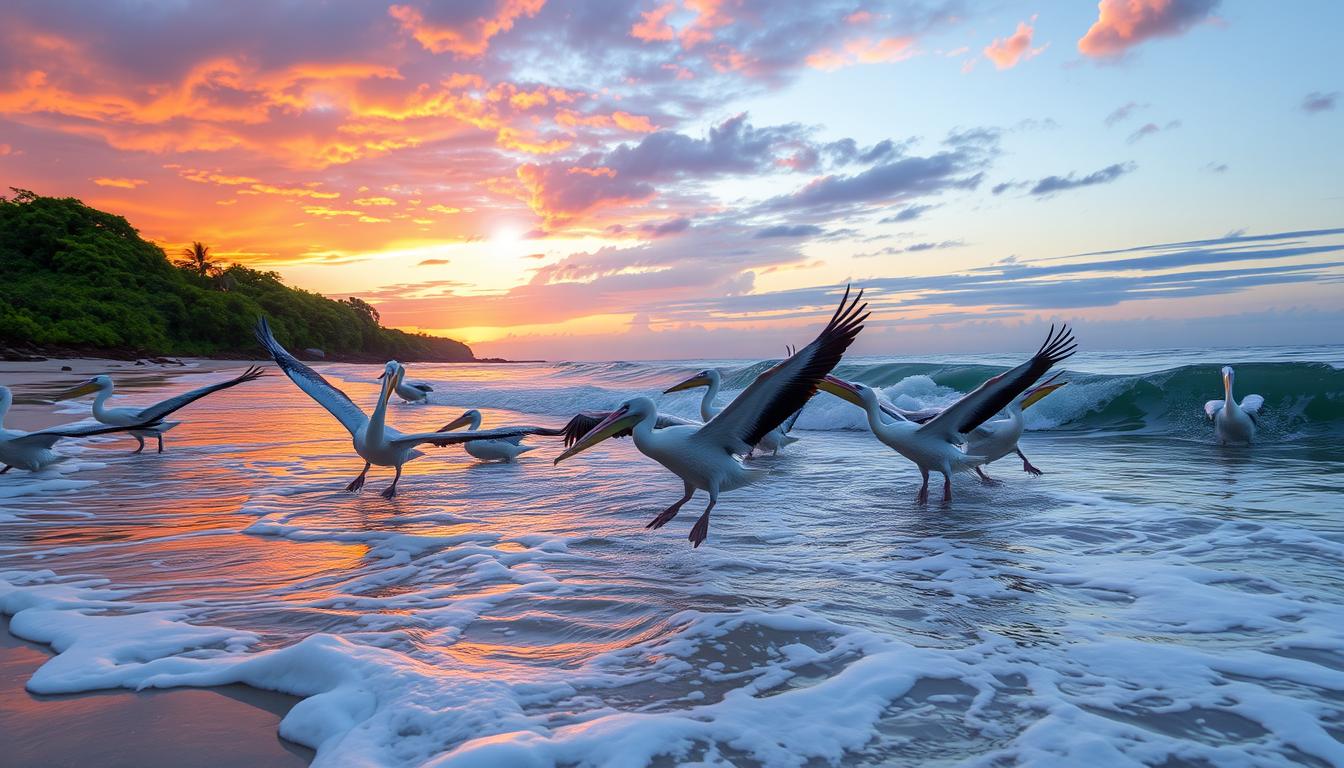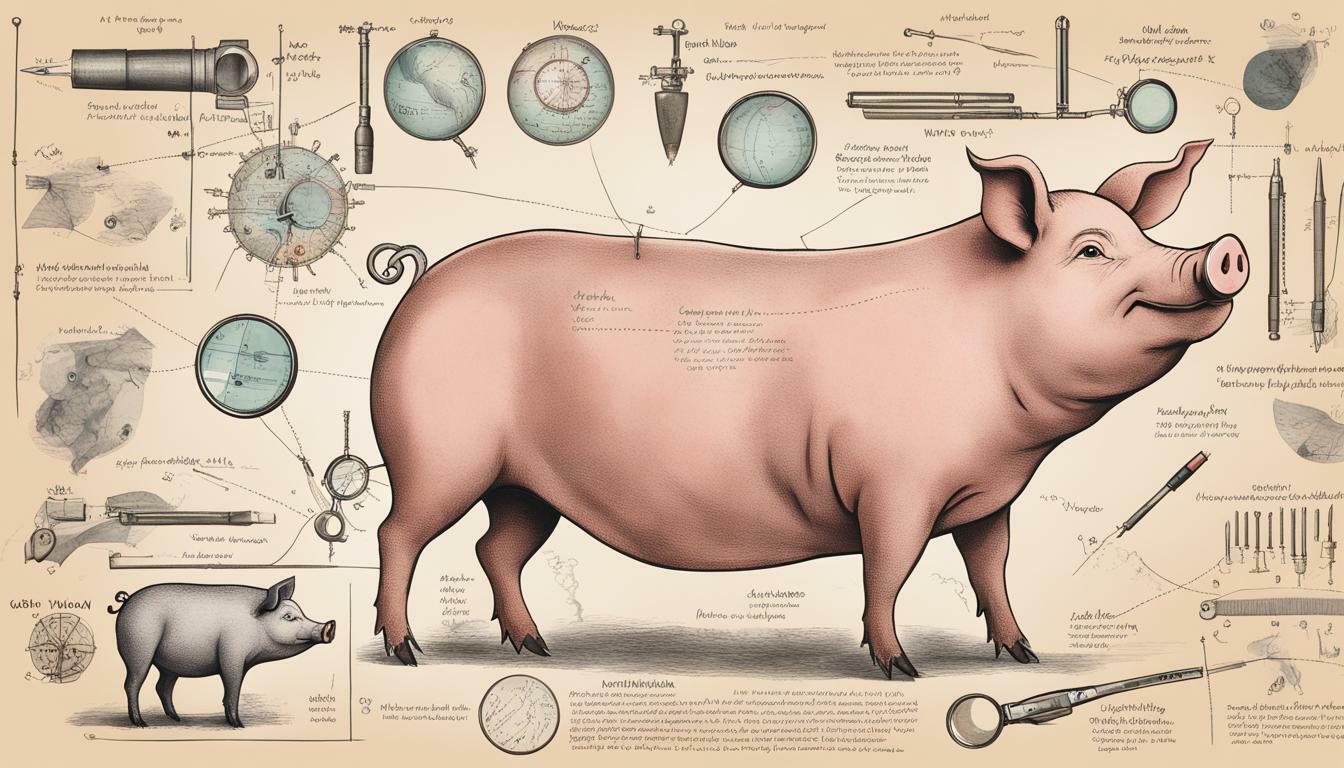Fascinating Facts About Pelicans: Masters of the Coastline

Table of content:
- Unique Physical Characteristics of Pelicans
- Adaptations for Survival and Hunting
- Geographic Distribution and Habitat Preferences
- Social Structure and Communication
- Pelicans in Culture and Mythology
- Conservation Status and Environmental Impact
- Record-Breaking Feats and Unique Facts
- The Future of Pelican Populations
- Conclusion
Get ready to be amazed by pelicans. These big water birds have been flying for over 30 million years. They have special pouches and are great at fishing. They live in many places, like oceans, rivers, and lakes.
There are eight kinds of pelicans. Each one is unique and has its own way of living. You might see the American White Pelican or the Dalmatian Pelican.
Pelicans like to be with others. They hunt and live in groups. They can fly really fast, up to 35 mph (56 km/h). Watching them fly or hunt is amazing.
Unique Physical Characteristics of Pelicans
Pelicans are amazing birds. They are big, have cool features, and bright colors. Each type of pelican is special in its own way.
Impressive Size and Weight Range
The brown pelican and white pelican are huge. They can grow up to 5 feet tall. Their wings can spread up to 10 feet wide, and they can weigh up to 20 pounds.
For comparison, the great blue heron is much smaller. It weighs only about 5 pounds.
Distinctive Beak and Expansive Pouch Capabilities
Pelicans have long beaks and big throat pouches. Their beaks can be up to 18 inches long. This helps them catch lots of fish.
Their pouches can hold up to 3 gallons of water. This makes them great hunters.
Vibrant Plumage and Color Variations
Pelicans have beautiful feathers. They can be white, cream, brown, or black. Some, like the Peruvian and brown pelican, get even more colorful during breeding season.
Pelicans are truly amazing. Their size and features help them live in coastal and aquatic places. They are a joy to watch for bird lovers and nature fans.
Adaptations for Survival and Hunting
Pelicans are amazing birds with special fishing skills. They live in saltwater and eat fish like mullet and sardines. Their big pouches and diving skills help them catch fish.
Specialized Fishing Techniques
Pelicans have different ways to catch fish. The Brown Pelican dives headfirst to catch fish. Others scoop fish up while swimming, using their pouches to drain water.
Unique Adaptations to Saltwater Environments
Pelicans are well adapted to saltwater. They have a gular flutter cooling system and waterproof feathers. These help them hunt and survive in coastal areas.
How Pelicans Consume and Store Food in Their Pouch
Pelicans have a big throat pouch that can hold lots of water. This pouch helps them catch and eat fish. It also stores food before they swallow it.
Pelicans are experts of the coastline. They have special fish catching skills and a gular flutter cooling system. Their feeding behaviors show how amazing nature is.
Geographic Distribution and Habitat Preferences
Pelicans live in many places around the world. They can be found from North and South America to Europe, Asia, Africa, and Australia. These birds love different places like coasts, seas, and lakes. They change how they act and look to fit their homes.
Global Range and Migration Patterns
The brown pelican lives in a wide area. It goes from Canada’s west coast to northern Peru on the Pacific side. On the Atlantic side, it goes from the northern United States to northern Brazil. Some pelicans stay in their homes all year. Others move with the seasons to find food.
Preferred Habitats: Coastal Waters, Lakes, and Estuaries
- Pelicans love shallow, warm coastal waters. They dive here to find food.
- They rest on sandbars, rocks, and in mangrove trees. These places are great for nesting and resting.
- Estuaries, lagoons, and lakes also have plenty of food. They are good places for pelicans to live.
Environmental Factors Impacting Pelican Populations
Pelicans face many dangers. Things like destroying their homes, pollution, and getting caught in fishing nets harm them. Climate change and oil spills also hurt their food supply. This puts their numbers at risk.
Social Structure and Communication
Pelicans live in groups and are often seen together. They build homes on secluded islands using sticks and reeds. Both parents take turns to care for their eggs and chicks, showing their strong bond.
Understanding Pelican Colony Dynamics
Pelican colonies are full of life. These birds work together to make sure the breeding season is successful. They fish together and roost in groups, showing their flock dynamics and social bird behavior.
Social Hierarchy and Group Behaviors
In the colonies, pelicans have a leader. The leader gets the best spots and resources. This helps the chicks survive, as the birds protect them together.
Communication Methods: Vocalizations and Body Language
Pelicans talk in sounds that sound like dinosaurs. They also use body language like wing displays and head movements. These help them talk to each other in the colony.
Pelicans in Culture and Mythology
Pelicans are famous in many cultures and myths. They are known for their special roles and symbols. People have been fascinated by them for a long time.
Symbolism of Pelicans in Different Cultures
In Christian stories, the pelican stands for Jesus Christ and giving up one’s life. This comes from a wrong idea that pelicans feed their babies with their blood. It shows Christ’s sacrifice for us.
In ancient Egypt, the pelican was linked to the god Ra. It was seen as a protector of the Nile River. In Native American cultures, the pelican means plenty and good luck. Its big pouch shows it can feed many.
Depictions in Art, Literature, and Folklore
Pelicans have been in art, books, and stories for a long time. They were mentioned in poems and plays from the Renaissance. They also show up in coats of arms.
In books, pelicans are often used to talk about big themes. Authors like Dante, John Lyly, and Shakespeare used them. They showed ideas like sacrifice, saving, and life’s cycle.
In art, pelicans are seen in many kinds of work. They are in religious pictures, coats of arms, and modern art. These works show the pelican’s special looks and its deep meaning in cultures.
Conservation Status and Environmental Impact
Pelican species have different conservation statuses. Most are listed as Least Concern by the International Union for Conservation of Nature (IUCN). But, the Dalmatian Pelican is Near Threatened because of habitat loss and human threats.
The Brown Pelican was once in big trouble. Pesticides, like DDT, made their eggs weak. This led to a big drop in their numbers.
Success Stories in Pelican Conservation
Thanks to conservation, some pelicans are doing better. The Brown Pelican was saved from being endangered. It was removed from the list in 2009.
This success came after DDT was banned in 1972. This ban helped the Brown Pelican recover and grow again.
Current Threats: Pollution, Climate Change, and Habitat Loss
Even with successes, pelicans still face many dangers. Pollution, like oil spills and plastic, harms them a lot. The 2010 Deepwater Horizon oil spill killed 82,000 birds, including many brown pelicans.
Climate change and losing habitats also threaten them. These changes mess up their breeding and finding food and homes.
How Conservation Efforts Benefit Broader Ecosystems
Helping pelicans also helps the places they live. As top predators, they keep coastal and aquatic areas healthy. Saving pelicans makes these ecosystems better for all living things.
Record-Breaking Feats and Unique Facts
Pelicans are amazing birds. They have big wings and fly high. They also have special traits that make them stand out.
Record Wingspans and Flight Altitudes
The Dalmatian Pelican flies high, over 10,000 feet. The great white pelican has a huge 11.8-foot wingspan. It’s one of the biggest flying birds.
Unique Species-Specific Behaviors
- Male Dalmatian Pelicans make up to 40 trips a day for four to five days. They use their pouch to carry nesting materials.
- Brown Pelicans can drop steeply before diving into the water to catch fish.
- Pelicans have air sacs in their bones. This makes them buoyant and helps them float on water.
Surprising Pelican Facts You Didn’t Know
- Pelicans are good flyers. They travel long distances by gliding on thermals with little energy.
- They have a light skeleton. This makes up only 10% of their body weight. It helps them have big wings and stay light.
- Pelicans look similar to their ancient relatives. Fossils show they’ve stayed the same for 30-36 million years.
Pelicans are amazing birds of the coast. They have big wings and fly high. They also have special ways of flying and living that make them unique and interesting.
The Future of Pelican Populations
Pelicans face big challenges ahead. Habitat loss, pollution, and climate change are big worries. But, there are plans to help these amazing birds.
Emerging Challenges and Conservation Strategies
Pelicans lose their homes due to coastal development and oil spills. Environmental concerns hurt their habitat preferences. To help, efforts are made to save their homes, like Queen Bess Island in Louisiana.
Research helps find new problems and solve them. By knowing about environmental concerns, habitat preferences, and population trends, we can help pelicans better.
Role of Pelicans in Marine Ecosystem Health
Pelicans are key to marine health. They keep fish populations in check. They also show us how the marine world is doing.
Protecting pelicans is crucial for our oceans. By tackling challenges and saving their homes, we help the whole ecosystem. This way, pelicans can keep flying for many years.
Conclusion
Pelicans are amazing birds that have caught our attention for thousands of years. They have cool looks and special ways of living and hunting. These birds are great at living in different places by the water all over the world.
Some pelicans have had big problems, like being very close to disappearing. But, thanks to people working hard to save them, many are doing well again. This shows how important it is to protect these birds.
We need to keep learning about pelicans and why they are so important. They help keep the water and coastlines healthy. By taking care of their homes, we can make sure they stay with us for a long time.
Pelicans are not just interesting to study. They also show us how nature can bounce back. Their story teaches us about the good things we can do for the environment. Let’s keep working to save these special birds and the world they live in.
Welcome. I’m Adreena Shanum, the proud owner of this website, and I am incredibly passionate about animals, especially poultry. I founded adreenapets.com as a labor of love, stemming from my desire to share my knowledge and experiences with poultry enthusiasts worldwide.




